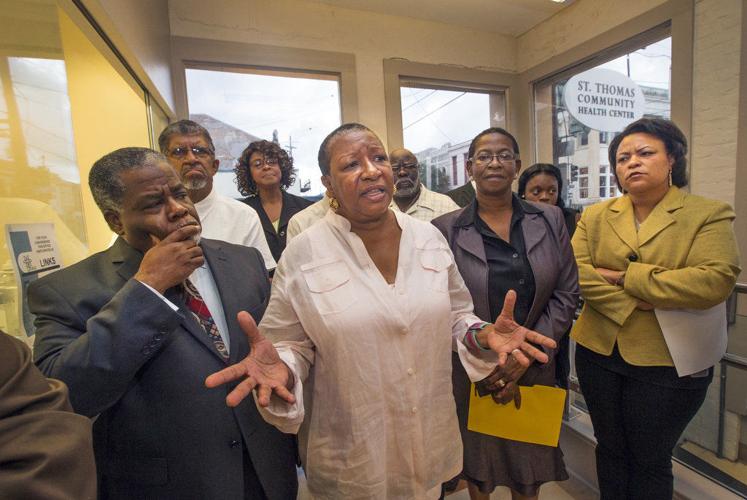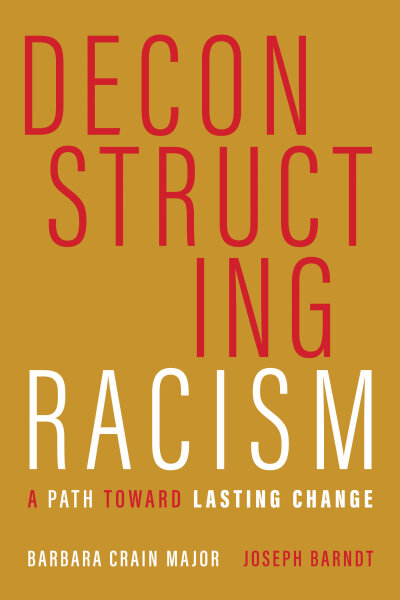Deconstructing Racism: A Path Toward Lasting Change by Barbara Major and Joseph Barndt
by Orissa Arend
The book is new; but the authors’ involvement with my church is not. Barbara and Joe are anti-racist trainers and organizers, each with a lifetime of experience. However, their experiences are very different. Joe is an 88-year-old white Lutheran pastor and respected author. As we so blithely put it, he’s not from here. Barbara is somewhat younger and Black, a long-time pillar of the New Orleans community. She was not a church person when she met Joe; and she had never planned to write a book.
I met them both 25 or so years ago when Joe was running Crossroads Ministries and Barbara was a fiery trainer for the People’s Institute for Survival and Beyond. Today, both are core trainers for the Institute.
Book Attempts to Dismantle Racism
In the early 90’s, my church, Trinity, a wealthy, conservative Episcopal church bordering the Garden District was trying to figure out how to become an anti-racist church. That was the language we used. But we never put ourselves in a position to be accountable to anyone but ourselves. So really, we were trying to be non-racist. We were trying to not be racist. However, “non-racist” is a category that does not exist. Unless we are actively working to dismantle racist systems, which involves the hard work of honest accountability to people of color, we are part of the problem.
These were our good-faith efforts: We joined the St. Thomas Irish Channel Consortium (STICC, as in forget the carrot) and spent a lot of time in the People’s Institute’s Undoing Racism workshops. These workshops were transformative two-and-a-half day affairs. We formed an internal group called Trinity Undoing Racism Now (TURN.) Joe and Crossroads, a sister organization to the People’s Institute, trained and consulted with TURN.

One of the hardest things in the world for white people to do is to take direction from Black people. We find it difficult to let Black people define the terms, set the agenda, make the decisions even about matters of race. STICC and TURN and the Institute gave us at Trinity plenty of opportunities to try. Some of us, a small but committed part of the congregation, were oh so very willing. We tried mightily for 10 or so years. Most of the time we failed. STICC actually gave us a failing letter grade in one humbling public meeting! Sometimes we learned from our mistakes.
Related: Undoing Racism Work Continues
That was back when the St. Thomas Housing Project was a vibrant functioning community with a strong resident’s council and a disciplined community safety patrol called Black Men United for Change. Barbara ran the St. Thomas Health Clinic on principles of accountability to the people it served. Trinity’s counseling center interns, who worked in and around St. Thomas, relished the opportunity to attend Communiversity, taught by the Institute, to learn how to go beyond being well-meaning do-gooders. Our rector told me that in his retirement he wanted to become an anti-racism trainer. That was then.
Our cadre at Trinity knew back then that racism was more than bigotry or individual race prejudice – that it was rooted deeply in our systems and institutions, including the church. None of this was commonly accepted at the time. We felt the excitement of being on the cutting edge. It kindled in us an evangelical spirit, rare at our staid church.

Fast-forward a couple of decades. Barbara and Joe wrote this book during the pandemic, after the brutal murder of George Floyd in 2020. It was becoming clear to many Americans that racism is indeed systemic and vicious and cunning and evil and that it will never fade away of its own accord. Barbara and Joe saw an opportunity in this new awareness to take the long view. They examine two distinct efforts to reconstruct American society without obvious racism. They looked at the first Reconstruction after the Civil War (1865-1877) and the second Reconstruction, the Civil Rights movement (1954-1968). Both were brief and both were stymied by violent back-lash. Barbara and Joe wanted to glean lessons from these reconstructions to prepare us for the hoped-for third Reconstruction. “God is giving us another chance to get it right,” they believe.
These first Reconstructions didn’t stick, the authors claim, because we never deconstructed the myth, the lie, of race. Deconstruction of this tragic illusion involves some shocking ideas. For example:
1) Racism is real. Race is not. This nation must ultimately abolish the concept of race which is a complete fiction, an illusion, dreamed up rather recently (during the 17th and 18th centuries) for nefarious reasons – colonization, slavery, white supremacy, materialistic greed.
2) Racism can be ended. This is not an unrealistic or whimsical wish or dream.
3) Race is nowhere to be found in the Bible.
4) “Power is the ability to become all that God intends us to be. Power is not evil; nor is it neutral. Power is good. Racism is the misuse of God’s good power,” the authors explain.
5) Racism morphs in sneaky ways. Following the Civil Rights movement “multicultural diversity and inclusiveness programs and social services proved a way to distract us from the struggle to end systemic racism,” Barbara and Joe note. Charity easily becomes paternalism. Advocacy can drown out the voices of those we speak for. This is “friendly” racism.
6) Many of the foundational documents of our nation need to be completely rewritten. Their footnotes (amendments) don’t negate the fact that they were written to protect white people exclusively and preserve white power.
Book Attempts to Dismantle Racism
Maybe it’s not a good idea to cherry pick these possibly shocking ideas. But if any of them challenge you, I encourage you to read the book’s convincing context and evidence for each one. As Barbara said at a recent book signing, “Don’t get mad at the truth. Question the lie that made you comfortable.”
I was particularly interested in the deconstruction strategy in the book. We attempted that decades ago at Trinity. We formed a team. And we got trained. We worked through many of our issues with each other. We forged authentic relationships. After a couple of years, our ad hoc team was officially commissioned as an anti-racist organizing team by our governing body, the vestry. We developed a long-term strategic plan to provide anti-racist training to staff and volunteer leaders. We planned for the deconstruction of race-based identity, history, and culture at Trinity through an examination of mission, vision, tradition, by-laws – places where the roots of racism abide and hide. That took about 10 years. We were surprised that it took that long; but we shouldn’t have been.
But that’s as far as we got. If we want to measure outcomes for ending racism, we have to measure results. Today the “anti-racist” training at Trinity is shorter, more transactional or superficial, less transformative and systemic. Our sanctioned ad hoc team was disbanded in favor of various committees. Some of these committees have established relationship with organizations run by people of color like Justice and Beyond, Ubuntu Village, Sixth Baptist Church. But where is our accountability? We haven’t attracted many congregants of color.
Click link to purchase Book Attempts to Dismantle Racism
I sense some re-claiming of our sacred stories. Our rector, Andrew Thayer, proclaims the Gospel as the revolutionary, egalitarian tome that it is. I think we are better listeners and readers and critics of the world around us than we used to be. Our Bishop has formed a committee to promote racial healing in our diocese because we realize that racism works against our Baptismal Covenant. Bishop Morris Thompson sent one of his priests to the Justice and Beyond Reparations town hall meeting to acknowledge the long list of racial harms committed in our diocese in the name of the Church and to apologize.
When some of the “remnants” of that original anti-racist Trinity group sat down with Joe recently for brunch at the beautiful Peter and Paul Hotel, we asked for his advice about how to go forward. I came away with more questions than answers but with a new determination to work within the church that I love, to uproot for good the lie that race even exists.
Take time and read a book that attempts to dismantle racism.
Orissa Arend is author of Showdown in Desire: The Black Panthers Take a Stand in New Orleans, a member of Trinity Church, and a pillar representative for Trinity Church to Justice and Beyond. She can be reached at arendsaxer@bellsouth.net.

